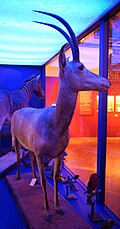Wikipedia:Today's featured article/November 17, 2016
The bluebuck (Hippotragus leucophaeus), now extinct, was a South African antelope. Classified in the same genus as the roan antelope and sable antelope, it was smaller than either. The largest mounted bluebuck specimen is 119 centimetres (47 in) tall at the withers, with horns measuring 56.5 centimetres (22.2 in) along the curve. The bluebuck's coat was bluish-grey, with a pale whitish belly. It was a grazer, and may have calved where rainfall would peak. When encountered by Europeans, it was confined to a 4,300-square-kilometre (1,700 sq mi) grassland habitat of the southwestern Cape, but fossils and rock paintings give evidence of a larger distribution. The first published mention of the bluebuck is from 1681. The few 18th-century illustrations appear to have been based on stuffed specimens. Hunted by European settlers, the bluebuck was the first large African mammal that went extinct in historical times, around 1800. Only four mounted specimens remain, in museums in Leiden, Stockholm, Vienna, and Paris; other museums contain skulls and horns. (Full article...)

